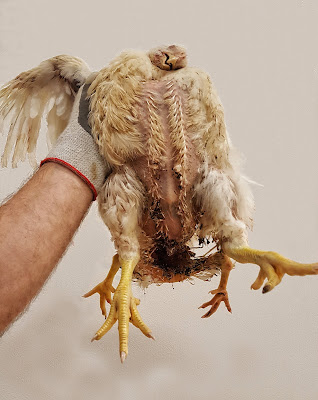Polymelus broiler
Keywords: polymelia, poultry, aves
The state of polymelia (polymelus is the adjective) should not be confused with polydactilia. The former refers to an excessive number of limbs, the latter to an excess of digits. Polydactilia in birds has been associated with a genetic defect while polymelia results from incomplete division of co-twins soon after fertilization; its cause is not clear. Examples of polymelia in calves are shown elsewhere in LORI.
Figure 1. A 7 week old polymelus broiler with duplication of the hind legs and probably the pelvis too. Image size: 1600 x 2500 px
The 7 week old broiler shown in figure 1 had a complete set of duplicate legs, situated caudal to the normal legs. Previously, this would have been termed a polymelus monster. Contemporary sensibility suggests that the term monster should not be used in such cases. The sex of this bird was not determined.
In some cases of polymelia, the excess limb or limbs are separated from the skeleton of the surviving individual. In other cases, they are joined to its skeleton. Radiographic studies were not performed to ascertain any degree of skeletal fusion.
There are numerous published reports of polymelia in poultry. In one case report, the extra set of limbs was surgically removed. This leaves one to ponder on the possible culinary fate of others.
Selected references:
Abu-Seida, A,M. 2014. Amputation of polymelia in a layer chicken. Avian Diseases: 58: 330-332.
Ajayi, I.E. and Mailafia, S. 2011. Occurrence of polymelia in 9-week-old male broiler: anatomical and radiological aspects. J. Vet.Anat. 4:69-67
OL, A and Oyagbemi, A.A.2013. First report of polymelia and a rudimentary wing in a Nigerian Nera black chicken. J.SAVA 27:84
PoultryDVM. 2019. Polymelia http://www.poultrydvm.com/condition/polymelia

